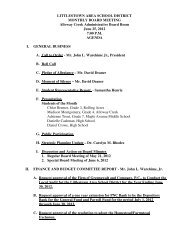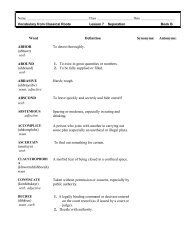Forces in Motion Forces in Motion
Forces in Motion Forces in Motion
Forces in Motion Forces in Motion
Create successful ePaper yourself
Turn your PDF publications into a flip-book with our unique Google optimized e-Paper software.
140<br />
Self-Check<br />
Which is more affected<br />
by air resistance—a<br />
leaf or an acorn? (See<br />
page 724 to check your<br />
answer.)<br />
Figure 3 The force of gravity pulls<br />
the object downward as the force<br />
of air resistance pushes it upward.<br />
Figure 4<br />
The parachute<br />
<strong>in</strong>creases the air<br />
resistance of this<br />
sky diver, slow<strong>in</strong>g<br />
him to a safe<br />
term<strong>in</strong>al velocity.<br />
Chapter 6<br />
Air Resistance Affects Some Objects More than Others<br />
The amount of air resistance act<strong>in</strong>g on an object depends on<br />
the size and shape of the object. Air resistance affects the flat<br />
sheet of paper more than the crumpled one, caus<strong>in</strong>g the flat<br />
sheet to fall more slowly than the crumpled one. Because air<br />
is all around you, any fall<strong>in</strong>g object you see is affected by air<br />
resistance. Figure 3 shows the effect of air resistance on the<br />
downward acceleration of a fall<strong>in</strong>g object.<br />
This arrow represents the force of air<br />
resistance push<strong>in</strong>g up on the object.<br />
This force is subtracted from the force<br />
of gravity to produce the net force.<br />
This arrow represents the net force<br />
on the object. Because the net force<br />
is not zero, the object still accelerates<br />
downward, but not as fast as it<br />
would without air resistance.<br />
This arrow represents the force of gravity<br />
on the object. If this were the only force<br />
act<strong>in</strong>g on the object, it would accelerate<br />
at a rate of 9.8 m/s/s.<br />
Acceleration Stops at the Term<strong>in</strong>al Velocity<br />
As long as the net force on a fall<strong>in</strong>g object<br />
is not zero, the object accelerates downward.<br />
But the amount of air resistance on an<br />
object <strong>in</strong>creases as the speed of the object<br />
<strong>in</strong>creases. As an object falls, the upward force<br />
of air resistance cont<strong>in</strong>ues to <strong>in</strong>crease until it<br />
exactly matches the downward force of gravity.<br />
When this happens, the net force is zero, and the<br />
object stops accelerat<strong>in</strong>g. The object then falls at a constant<br />
velocity, which is called the term<strong>in</strong>al velocity.<br />
Sometimes the fact that fall<strong>in</strong>g objects have a term<strong>in</strong>al<br />
velocity is a good th<strong>in</strong>g. The term<strong>in</strong>al velocity of hailstones is<br />
between 5 and 40 m/s, depend<strong>in</strong>g on the size of the stones.<br />
Every year cars, build<strong>in</strong>gs, and vegetation are all severely damaged<br />
<strong>in</strong> hail storms. Imag<strong>in</strong>e how much more destructive hail<br />
would be if there were no air resistance—hailstones would hit<br />
the Earth at velocities near 350 m/s! Figure 4 shows another<br />
situation <strong>in</strong> which term<strong>in</strong>al velocity is helpful.<br />
Copyright © by Holt, R<strong>in</strong>ehart and W<strong>in</strong>ston. All rights reserved.





